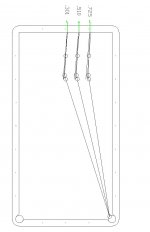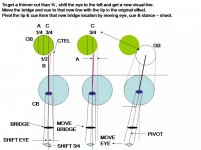I am hoping everybody can agree to end to all of the immature and childish schoolyard exchanges before yet another CTE thread is killed by the almighty AZB Administrators. If we are lucky, mature, and civil, maybe this thread can actually return to substantive, meaningful, and useful discussion and debate. How about we return to Stan's original question, before things got out of control:
Here are the three famous (or infamous) shots that you specifically address on your DVD:
Shot "A" is about a 10-degree cut, shot "B" is about a 15-degree cut, and shot "C" is about a 20-degree cut. All three shots fit into the "thick cut" category of CTE. Also, the CB-to-OB distance is the same for all three shots. If the bridge length and pivot amount is the same for all three shots, a pertinent question is: What do you do differently with the alignment and/or pivot steps of CTE to pocket each of the three shots?
BTW, these three shots were brought up many years ago, long before your version of CTE came on the scene, so they were originally intended for discussion with
previous versions of CTE; although, they still apply in the current debate.
Some CTE/Pro-One users have seemed to claim that the same alignment and pivot is used for all three shots. Some seem to have claimed that a different alignment and/or pivot is used for each. There seems to be confusion about this in the CTE/Pro-One community. Honestly, I haven't watched your DVD in a while and don't remember which alignments and pivots you suggest. Regardless, for discussion purposes, instead of the 5 shots you request, let's make it 15 shots instead. Let's have the 15 shots be equally spaced between shots A and C above.
As is clear on your DVD and in
the brief summary of your approach, as interpreted by me, the alignment and pivot choices change with shot cut angle. As the cut angle changes in small increments between shots A and C, the choices for alignment and pivot change at certain points in the range. At each point where they change, because neighboring shots of the group of 15 are so close together, it seems reasonable to conclude that different alignments and pivots should be able to be used to pocket the same shot. It also seems reasonable that the alignment and pivot will not change for certain ranges of shots among the 15. Therefore, it would seem reasonable to conclude that a single alignment and pivot should be able to be used to create a range of cut angles. However, if you follow the
procedure listed here accurately and consistently (and don't make any "adjustments" whatsoever), it seems to me that it would result in the exact same cut angle every time for a selected alignment and pivot, and for a given CB-OB distance and chosen bridge length, assuming a rigid and fixed bridge. Obviously, this particular cut angle will work for some of the shots in the range, and it won't work for others (depending on the distance to and size of the pocket), because every shot in the range requires a different cut angle (assuming center-pocket aiming).
Now, does that mean you can't make CTE work for all shots at a table? Absolutely not. I have suggested
four ways it can be made to work, despite the apparent challenges. This is where the "visual intelligence," "adjustment," "experience-based intuition," and "feel" come into play. (Also, with enough practice, a person might be able to learn to do one or more of the four techniques suggested naturally and even subconsciously ... to where they might not even know they are doing them.) I certainly don't think there is anything wrong with a system that involves "experience-based intuition"; in fact, I think "aiming systems" and "pre-shot routines" like CTE and Pro-One offer
many real benefits for some people.
I hope that helps clarify things a little. I think these concepts and issues are at the heart of the controversy with align-and-pivot systems, as has been the case for 15 years.
BTW the way, I don't want to restart this whole debate again. It has gone on for too long and I feel I have addressed the issues as well as I possibly can in this post and on my resource pages. Although, I will continue to listen and learn if people share new and meaningful insight. I am also happy to clarify anything that is unclear in my explanation above (in response to any civil and mature questions or comments).
Regards,
Dave



